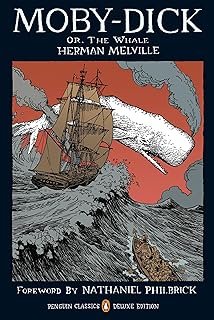Herman Melville, D.H. Lawrence, and the Etna Woman
By Stuart Mitchner
 In an interview in this Sunday’s New York Times, the actor Ed Helms (The Office) says his favorite reading experience took place on the subway, clinging to a pole with one hand and reading Moby-Dick on his cell phone with the other. It’s a connection that might have amused Herman Melville, who was riding the elevated subway to and from his job as a customs inspector until his retirement in 1886, five years before his death. I wish he were around to write a response to D.H. Lawrence’s wildly conflicted tribute to the “deep great artist” who wrote Moby-Dick, “a very great book” that “commands a stillness in the soul, an awe” that Lawrence found hard to match with the author, a “rather tiresome New Englander” — “Oh dear, when the solemn ass brays! brays! brays!”
In an interview in this Sunday’s New York Times, the actor Ed Helms (The Office) says his favorite reading experience took place on the subway, clinging to a pole with one hand and reading Moby-Dick on his cell phone with the other. It’s a connection that might have amused Herman Melville, who was riding the elevated subway to and from his job as a customs inspector until his retirement in 1886, five years before his death. I wish he were around to write a response to D.H. Lawrence’s wildly conflicted tribute to the “deep great artist” who wrote Moby-Dick, “a very great book” that “commands a stillness in the soul, an awe” that Lawrence found hard to match with the author, a “rather tiresome New Englander” — “Oh dear, when the solemn ass brays! brays! brays!”
My guess is that besides savoring words of praise from a brilliant colleague, a man with Melville’s wonderfully inventive sense of humor would laugh at the “solemn ass,” and, if it were possible, post Lawrence a copy of his sketch “Cock-a-Doodle-Doo!” about “the loudest, longest, and most strangely musical crow that ever amazed mortal man…. a wise crow; an invincible crow; a philosophic crow; a crow of all crows.”
Braying and Bleating
 When it comes to braying, however, Lawrence is in a class by himself in the Taormina poems from Birds, Beasts and Flowers (1923), where he seems to be rehearsing for his energetic wake-up calls to Poe, Whitman, Hawthorne, Melville, and others in Studies in Classic American Literature (1925). In “The Ass,” there’s even a Lawrentian translation of the “long-drawn bray of the ass in the Sicilian twilight — All mares are dead!!Oh-h!Oh-h-h!Oh-h-h-h-h—h!!I can’t bear it, I can’t bear it, I can’t!” Not to mention Lawrence’s Sicilian “She-Goat” bleating for him to come down and untie her when the herd goes by at dawn: Merr—err—err! Merr—er—errr! Mer! Mé!” Lawrence being Lawrence, he answers her in his own tongue: “Wait, wait a bit, I’ll come when I’ve lit the fire.”
When it comes to braying, however, Lawrence is in a class by himself in the Taormina poems from Birds, Beasts and Flowers (1923), where he seems to be rehearsing for his energetic wake-up calls to Poe, Whitman, Hawthorne, Melville, and others in Studies in Classic American Literature (1925). In “The Ass,” there’s even a Lawrentian translation of the “long-drawn bray of the ass in the Sicilian twilight — All mares are dead!!Oh-h!Oh-h-h!Oh-h-h-h-h—h!!I can’t bear it, I can’t bear it, I can’t!” Not to mention Lawrence’s Sicilian “She-Goat” bleating for him to come down and untie her when the herd goes by at dawn: Merr—err—err! Merr—er—errr! Mer! Mé!” Lawrence being Lawrence, he answers her in his own tongue: “Wait, wait a bit, I’ll come when I’ve lit the fire.”
The Etna Woman
I hadn’t read Lawrence’s Taormina poems at the time I lived there, from mid-February to April 1963. My discovery of Birds, Beasts, and Flowers was six years away in a graduate seminar on his poetry.
One Sunday in early March I found myself sharing a flight of very steep steps with a black-clad “peasant woman” — my first impression until I got a better look at her and she began expounding on life and death, hellfire and heaven, mathematics, science, and philosophy in excellent English, with what sounded like a slight German accent. Since she was sweating and out of breath, I helped her carry the large pail of water she was toting, she gripping one end of the handle, I the other. She lived in the village of Castelmola, which looks directly across at Mount Etna and straight down on Taormina, the emphasis on down because Taormina itself is very high up.
After we reached the top of the steps, she led the way to a small brick hut perched on a ledge all its own, where for the better part of an hour we sat looking out on the Ionian Sea and the white crest of Etna. The description of the woman’s face in a letter to my parents — a “brimstone burnt-gold color from years of sun” — may have been influenced by her frequent references to the volcano and the fire at its core. The way she gazed at the white summit suggested a long-term relationship, as if she knew it and it knew her.
The first thing she asked was what I “did with my life.” When I told her I was a writer, she asked Why do I write, and what about? Having admitted that she’d done “much reading” when she was young, she said she trusted that I didn’t write “romances” about how beautiful everything is. Speaking in a strong, but halting voice, she said she hoped I would show that there were two heavens, one for stupid people who think it is going to come after they die and one for people who know that it is now and that if there is a real god he must be God and the Devil both together. When I said something about the beauty of Etna, as if the volcano were a close friend it would have been rude not to admire, she told me to think of the thousands and thousands of people who had burned in the fires of its eruptions and been buried alive in its lava. One of the few things she said that I later wrote down word for word was that Catholics are “marionettes and God a fake puppetmaster.”
Shocks of Recognition
Six years after the incident with the Etna woman, I read Lawrence’s Taormina poems for the first time, struck by the way certain lines echoed that strange conversation. From “Peace”: “My heart will know no peace till the hill bursts…. Forests, cities, bridges gone again in the bright trail of lava.” From “Almond Blossom”: “Flying not down from heaven, but storming up, strange storming up from the dense under-earth.” From “Purple Anemones”: “Who gave us flowers? Heaven? The white God? Nonsense! Up out of hell, from Hades; Infernal Dis!” From “Snake”: “Being earth-brown, earth-golden from the burning bowels of the earth on the day of Sicilian July, with Etna smoking.”
Perhaps the most striking echo came from “Hibiscus and Salvia Flowers,” Lawrence’s response to “red-decked socialists” marching one Sunday on Taormina’s Corso in their “yellow shoes.” After extolling “dragon-mouthed salvia with gold throat of wrath! Flame-flushed, enraged, splendid salvia,” Lawrence longs “to be a bolshevist and set the stinking rubbish-heap of this foul world afire at a myriad scarlet points, a bolshevist, a salvia-face to lick the world with flame that licks it clean.”
Melville in Taos
Writing about Melville two years later in Taos, New Mexico, Lawrence closes his essay by quoting the last sentence of Moby-Dick, the sinking of the Pequod: “Now small fowls flew screaming over the yet yawning gulf; a sullen white surf beat against its steep sides; then all collapsed; and then the great shroud of the sea rolled on as it rolled five thousand years ago.”
After declaring Melville’s novel “one of the strangest and most wonderful books in the world, closing up its mystery and its tortured symbolism,” Lawrence riffs on Doom: “Something seems to whisper it in the very dark trees of America. Doom! Doom of what? Doom of our white day. We are doomed, doomed. And the doom is in America. The doom of our white day. Ah, well, if my day is doomed, and I am doomed with my day, it is something greater than I which dooms me, so I accept my doom as a sign of the greatness which is more than I am.”
Never mind what Melville would think about someone reading Moby-Dick on the subway in the year 2025, what would the man who died in 1891, a little over 30 years before Lawrence declared the Pequod “the ship of the white American soul,” make of this coda? — “Melville knew. He knew his race was doomed. His white soul, doomed. His great white epoch, doomed. Himself, doomed. The idealist, doomed. The spirit, doomed…. But Moby-Dick was published in 1851. If the Great White Whale sank the ship of the Great White Soul in 1851, what’s been happening ever since?”
1923
1923 is the year Lawrence’s Taormina poems were published in America by Thomas Seltzer. Thanks to Taylor Sheriidan’s extraordinary series 1923, it’s no longer possible to mention that year without taking into account works Americans may have been watching and reading around the same time, as I did a month ago writing about Charles Chaplin’s The Pilgrim, where the Tramp escapes from prison onto a train bound for Desert Gulch, Texas, the state that borders New Mexico, where Lawrence was in Taos writing his scathing, soulful Studies in Classic American Literature.
Some friends who heard of my encounter with the woman who knew Mount Etna jumped on my reference to the possibility that she had a German accent. What if I’d been talking with Lawrence’s widow Frieda on that memorable Sunday in March 1963? A nice thought, in a column already top heavy with nice impossible thoughts; in fact, Frieda died in Taos in August 1956, 26 years after Lawrence, who died in Vence, France, on March 2, 1930.

